Review of the Chinese DPSS 532nm laser: emitter
In the first part of the review, I measured the laser parameters stated in the description and spoke about the shortcomings in the design of the power supply. Now it was the turn to consider how the emitter itself was arranged.

To make it clear what is inside and why it is needed there, I would like to start with a brief description of how lasers work in general. So:
A laser is an ingeniously simple device for understanding the principle of its functioning. At the same time, in order for the laser to work, you need to take into account a bunch of nuances, which opens up huge scope for the creativity of engineers. It’s like with an atomic bomb: there are two pieces of uranium in half of the critical mass, we add them - but no, something does not explode, it only flows onto boots.
We all know that if some energy is given to an atom or molecule of a substance, then after some time this atom / molecule will get rid of it - perhaps even by emitting a quantum of radiation (if it does not collide with any other atom earlier). This is spontaneous emission, and this is how the bulb works: the spiral is heated by electric current, the thermal energy of atoms (and tungsten and all impurities) is converted into radiation energy. In this case, the spectrum of such radiation approximately corresponds to the spectrum of an absolutely black body and represents a bunch of different wavelengths with a characteristic intensity peak for a given temperature.
At the same time, if a photon of a certain frequency is struck by an excited atom without waiting for the atom to slide to the lower energy level itself, then as a result of the absorption of such a photon, the atom will reduce its energy by the photon energy and release two completely identical photons identical to that flew in. Absolutely identical: in direction, in phase, in polarization, and, of course, in energy, i.e. wavelength. This is stimulated emission.
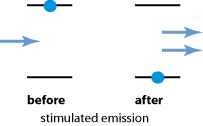
If we have many identical excited atoms, then the probability is high that a “bifurcated” photon will hit such an atom, bifurcate again, etc., until the excited atoms run out in the direction of wave propagation. Thus, only one photon of the correct wavelength flying into space with our excited atoms multiplies - amplifies, and atoms lose energy. This makes it clear that in order for the laser to operate continuously, the emitting atoms need to be continuously informed of the energy, which transfers them back to the upper energy level - “pump up”. Moreover, for the successful amplification of atoms at the upper energy level there should be more than at the lower one, this state of matter is called "inverse population". A single passage of an amplified beam of quanta through a working fluid is usually not enough,
The atoms that will be discussed in the context of this laser are neodymium ions that are located at the lattice sites of the yttrium vanadate crystal. If they just hung out in a vacuum and were in the form of a gas, then the laser would be gas, and since they are "fixed" in the crystal, the laser turns out to be solid-state. The crystal is selected so that it is transparent to the wavelengths we need, strong mechanically, and is suitable for a number of other parameters that are not critical for understanding the operation. Actually, the yttrium YVO 4 vanadate crystal with an impurity (in other words, doping) with neodymium Nd is called the working fluid of the laser, and the entire formula is written as Nd: YVO 4. It is important to understand here that the main thing here is neodymium, and there are many crystals with suitable parameters for doping: Nd: Y 3 Al 5 O 12 (or shorter than Nd: YAG), Nd: YAlO 3 , etc. All have nuances but the essence is one.
In the example of stimulated emission, our atom had only two energy levels - the upper and lower, but the reality looks more severe:
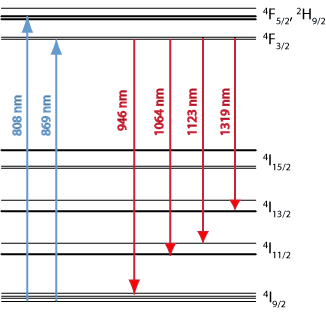
Here we see the “energy” levels of neodymium ion “interesting” in terms of radiation and absorption in a crystal of aluminum-yttrium garnet. It should be understood that a neodymium ion (like any quantum object) can only absorb quanta of certain wavelengths - the energy of which corresponds to the difference in energy of its levels. These are blue arrows.
Although energetically it is much more profitable to pump a crystal with a wavelength of 869nm, there are no powerful and cheap sources of such a wavelength. Therefore, laser diodes that emit 808nm (but intensely) are used, which drive the ions to a level higher than necessary. After a short time, a non-radiative transition to the 4 F 3/2 level occurs . This is the so-called metastable energy level. “Metastable” means that the ion remains at this level for a relatively long time, without discharging energy, but at the same time, this level is not basic (not with minimal energy). This is important because in this state the neodymium ion must “wait” for its quantum, which will be amplified with a transition to a lower level.
An excited neodymium ion can emit a quantum with one of four wavelengths suitable for further amplification (red arrows). Moreover, although the greatest probability of radiation is at a wavelength of 1064 nm, other transitions are also possible. They are struggling with them, using dichroic resonator mirrors, which reflect only waves 1064 nm long, and the rest are released outward, not allowing amplification in the resonator. Thus, one or more of the possible laser frequencies can be selected simply by replacing the mirrors.
So, pumping our crystal placed in the resonator with a laser diode, we get laser radiation with a wavelength of 1064nm. It is worth noting that neodymium can be pumped not only with a laser diode, but also with flash lamps and other radiation sources that have the desired wavelengths in the spectrum, i.e. it is the laser as a pump source that is not necessary here. It's just that a laser diode is very effective in terms of converting electrical energy into radiation of one frequency we need (the efficiency reaches more than 50%), and the fact that its radiation has polarization and coherence are positive, but not necessary qualities.
1064nm infrared radiation converts to 532nm green in a process called second harmonic generation (SHG). I’m afraid I won’t be able to explain the essence of this process in an accessible way without doubling the length of the article, so we just assume that the nonlinear crystal in which this happens is a black box that receives two quanta at the input and produces one, but twice the output . Moreover, the efficiency of this process depends on the amplitude of the wave corresponding to the quantum (this is its nonlinearity), therefore, looking through the crystal at the outside world, we will not see any color shifts - the light intensity is too low. But with laser energy densities, these effects manifest themselves in all their glory.
As with the working fluid, there are many nonlinear crystals: KTP (potassium titanyl phosphate, KTiOPO 4), LBO (lithium triborate, LiB 3 O 5 ) and many others - all with their pros and cons. In cw ( CW ) lasers, a nonlinear crystal is placed inside the cavity to achieve greater polarization of the dielectric due to the multiple passage of the infrared beam through the crystal and thereby increasing the efficiency of second harmonic generation. Lasers of this design are called intracavity second harmonic generation lasers. In pulsed lasers, this does not bother - the energy density in the pulse is enough to complicate the resonator.
All medium power DPSS lasers are built according to approximately the same optical design:

LD - pump diode, F - focusing lens, HR- an input mirror (transmits 808nm and reflects 1064nm), Nd: Cr - a neodymium-doped crystal (a reflective coating for 532nm is sprayed on its right surface scheme), KTP - a nonlinear crystal, OC - an output mirror (reflects 1064nm and passes everything else) .
HR and OC mirrors form a Fabry-Perot hemispherical resonator. The HR mirror is usually sprayed onto the crystal of the working fluid; they try to make it with maximum reflectivity for the wavelength generated by the laser. The reflectivity of the OC mirror is chosen so as to maximize the laser efficiency: the higher the gain of the medium (i.e., the fewer passes through the crystal with neodymium, the beam must be made to amplify sufficiently), the higher the transmittance.
As can be seen from the diagram, the only element that delays the emission of 808nm from the laser diode is the working medium crystal. Everything that he could not absorb passes through the mirrors into the exit aperture. Therefore, after the OC mirror, a dichroic filter is usually placed, reflecting the unabsorbed pump radiation.
Now, knowing the basic theoretical principles of laser operation and the fundamentals of its design, we can proceed to the next part.
We unscrew the bottom panel and get access to the four screws securing the top cover: Carefully remove the cover, moving it forward so as not to touch the lens of the lens: The laser itself occupies a relatively small volume of the emitter. One can see two aligned optic holders - this is a good sign: that means, firstly, there is something to align, and secondly, it means that the laser is not made by “gluing” the working fluid and the nonlinear crystal. Gluing is unsuitable for extraction of large capacities and cannot be adjusted.
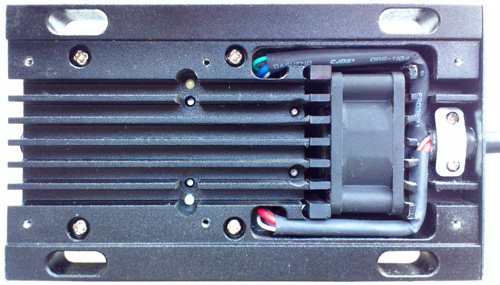
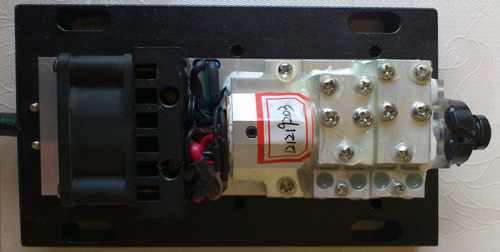
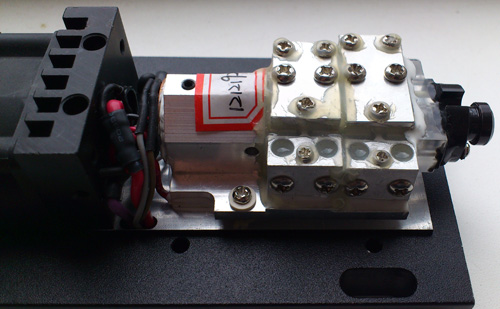
All slots are carefully coated with silicone gel, which prevents dust and moisture from entering the resonator. A pair of adjustment screws are located centrally on the top and to the side of each of the holders. The base of the laser is attached to the radiator with just two screws that press it against the thermocouple. Thus, the front edge of the platform simply hangs above the radiator, which raises doubts about the overall rigidity of the structure.
There is no free space between the optical elements: my idea of putting a mode diaphragm and an IR filter in front of the lens was doomed to failure. Of course, there is no question of frequency standards and other optical elements; laser design does not imply modification.
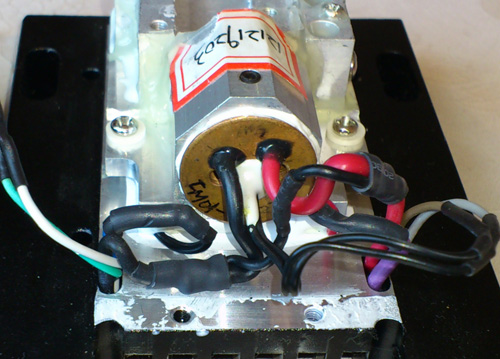
We remove the lens and both holders: A view of the yttrium vanadate crystal with a size of 5x5x3 mm opens up, which can withstand up to 15 watts of pumping and give up to about 6 watts of radiation at a wavelength of 1064 nm. The proportion of neodymium impurities is likely about 1 atomic percent. An antireflection coating for 1064nm and a reflective coating for 532nm is applied on this side.
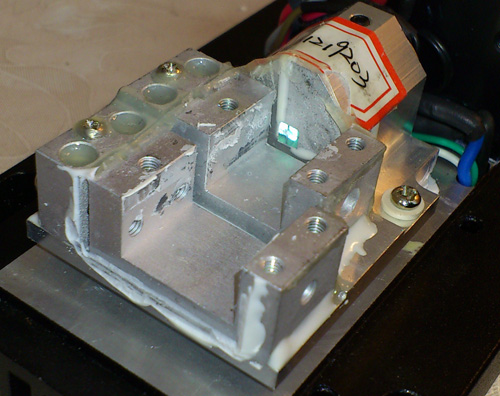
The holders are made of duralumin and allow alignment in the horizontal plane with side screws and in the vertical with top screws. The adjustment is supposed to be performed as follows: release both screws for one axis, then find the desired position of the holder with one of the screws and fix it with the second screw. The screws are the most common Chinese M3, not micrometric or accurate. The KTP crystal has dimensions of 3x3x7 mm, and theoretically can "serve" much greater power - up to about 20 W @ 532nm. An antireflection coating for waves with a length of 532 and 1064 nm, the reflection coefficient of which is less than 0.5%, is applied at its ends. To align the crystal, it would be nice to have a third degree of freedom - rotation along the axis of the resonator, but here the manufacturers relied on the accuracy of cutting and gluing.
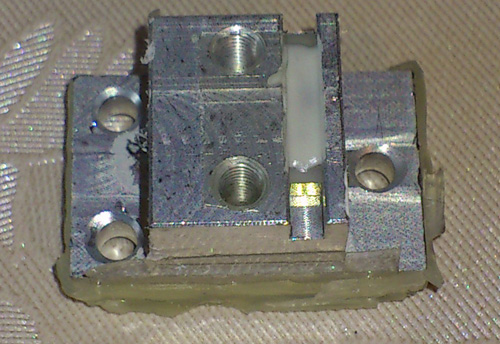
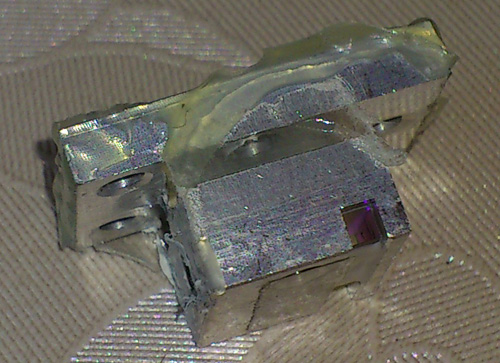
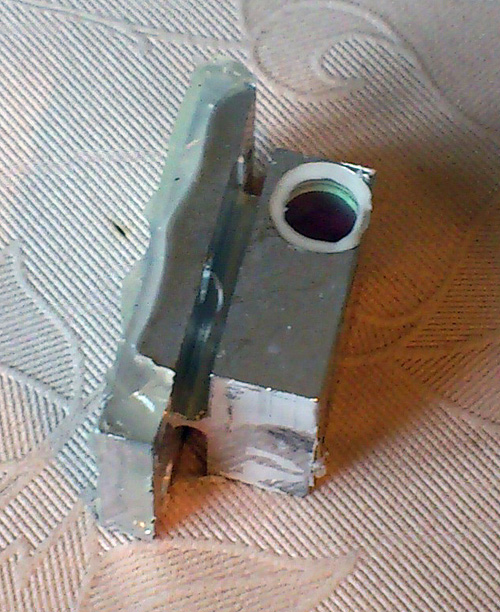
A dichroic concave mirror is glued into the output holder (concavity is not visible on the eye): it transmits light at a wavelength of 532 nm and reflects 1064 nm. In this case, a significant part of the 808nm radiation also passes through it.

The diode in the F-mount housing is mounted on a massive brass base with thermal grease applied to it. This type of housing has an opening for installing a thermistor that controls the temperature of the diode; the thermistor is present in a regular place. Diode manufactured by Focuslight; because in addition to the serial number, there is no other marking on it, its power, most likely, is 5 W - this is the lowest power for diodes in such a case, and it is logical to assume that the Chinese will not put anything more powerful and more expensive there. Based on datasheeton this type of diode, the maximum current is 5.5A, i.e. without exceeding the permissible values, the current set at the factory can be increased by 200 mA, which should add about 50 mW of output power. The diode can easily be replaced with a 10-watt one, since the remaining components allow it, and you can get more than 3 W of a green beam at the output (I can not judge its quality, stability and mode composition).
Mounting the diode allows you to rotate it along the axis of the resonator to select the optimal polarization of the pumping radiation.
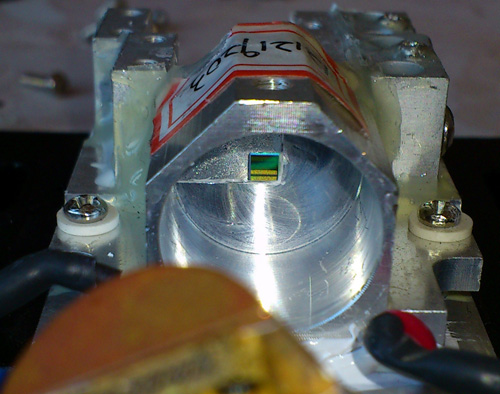
This side of the crystal is coated with an antireflection coating for 808nm and reflecting more than 99.5% for 1064nm, which forms a plane resonator mirror.
As you can see, there is no focusing optics between the diode and the crystal: this reduces the pump efficiency.
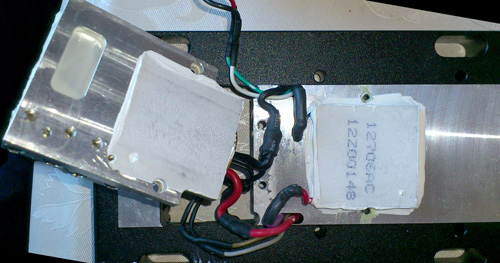
Under the base is a common Peltier element of the TEC1-12706 brand. Its characteristics: power supply up to 15V, current up to 6A, power output up to 50W at a hot surface temperature of 60 ° C; dimensions 40x40x4 mm. A hole was made under the output optics holder, probably for a heating element with a different layout: a nonlinear crystal would be mounted in this holder, focusing optics in the previous one, and the output mirror would be mounted separately (at the same time, this would partially solve the problem of thermal expansion of the base). But this is just my guess.
Needless to say, that after assembly, the laser did not work? However, I pretty quickly caught the generation by playing adjustments to the output mirror. Further adjustment of the mirror was not difficult. With the adjustment of the KTP crystal, everything turned out to be much more complicated: to be honest, I can not imagine how the Chinese did it, turning the Philips screws with a screwdriver. Therefore, I replaced all the adjustment screws with hexagon bolts, which made it possible to make a more accurate alignment with a key, without pressure on the fasteners.
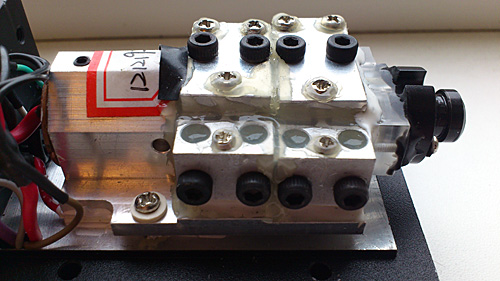
And despite this, I could not fix the exact critical KTP angle: all the same, the beam power jumps noticeably even with a simple pressure with a finger and even by itself. It should be noted here that the generation was in a very wide range of crystal alignment, but in some positions the power increased spasmodically and also spasmodically decreased under the slightest external disturbances. As a result, recalling the tale of the lab technician pounding pliers on the laser body to put the backlash mirror back in place, I managed to achieve a stable power of about 1650 mW, that is, the loss was about 200 mW.
Now it becomes clear why these lasers have such a large spread in power: it is possible that 1.8 W was made possible only thanks to a happy blow during transportation, and the laser came out of the factory with a completely different power. Unfortunately, no test form was attached to the laser.
They did not save on crystals in the laser: they allow much higher pump powers. I suppose that this was done for unification, and a three-watt laser differs from a single-watt one only in the power of the laser diode, power supply, and three times the price. The rigidity and accuracy of the mechanics leave much to be desired - you can see the desire to make inexpensively, but at least the design is repairable. The declared durability of the design, it seems, is mainly determined by the durability of the laser diode (and it was not possible to find it in the documentation) and the purity of the assembly room - I did not see any contaminants on the optics when disassembling the laser.
And to summarize, I want to answer the main question to the first part of the article, which arose among many - “Why is this laser needed at all?” Based on its power, insufficient for efficient pumping of titanium-sapphire and dyes, mode composition and stability, which also so-so, its main area of application is the OEM component for laser projectors. It can also be used for illumination purposes: for recording luminescence, in confocal microscopy, etc. areas where high backlight power is required at a relatively stable frequency.

To make it clear what is inside and why it is needed there, I would like to start with a brief description of how lasers work in general. So:
Theory (boring)
A laser is an ingeniously simple device for understanding the principle of its functioning. At the same time, in order for the laser to work, you need to take into account a bunch of nuances, which opens up huge scope for the creativity of engineers. It’s like with an atomic bomb: there are two pieces of uranium in half of the critical mass, we add them - but no, something does not explode, it only flows onto boots.
We all know that if some energy is given to an atom or molecule of a substance, then after some time this atom / molecule will get rid of it - perhaps even by emitting a quantum of radiation (if it does not collide with any other atom earlier). This is spontaneous emission, and this is how the bulb works: the spiral is heated by electric current, the thermal energy of atoms (and tungsten and all impurities) is converted into radiation energy. In this case, the spectrum of such radiation approximately corresponds to the spectrum of an absolutely black body and represents a bunch of different wavelengths with a characteristic intensity peak for a given temperature.
At the same time, if a photon of a certain frequency is struck by an excited atom without waiting for the atom to slide to the lower energy level itself, then as a result of the absorption of such a photon, the atom will reduce its energy by the photon energy and release two completely identical photons identical to that flew in. Absolutely identical: in direction, in phase, in polarization, and, of course, in energy, i.e. wavelength. This is stimulated emission.

If we have many identical excited atoms, then the probability is high that a “bifurcated” photon will hit such an atom, bifurcate again, etc., until the excited atoms run out in the direction of wave propagation. Thus, only one photon of the correct wavelength flying into space with our excited atoms multiplies - amplifies, and atoms lose energy. This makes it clear that in order for the laser to operate continuously, the emitting atoms need to be continuously informed of the energy, which transfers them back to the upper energy level - “pump up”. Moreover, for the successful amplification of atoms at the upper energy level there should be more than at the lower one, this state of matter is called "inverse population". A single passage of an amplified beam of quanta through a working fluid is usually not enough,
The atoms that will be discussed in the context of this laser are neodymium ions that are located at the lattice sites of the yttrium vanadate crystal. If they just hung out in a vacuum and were in the form of a gas, then the laser would be gas, and since they are "fixed" in the crystal, the laser turns out to be solid-state. The crystal is selected so that it is transparent to the wavelengths we need, strong mechanically, and is suitable for a number of other parameters that are not critical for understanding the operation. Actually, the yttrium YVO 4 vanadate crystal with an impurity (in other words, doping) with neodymium Nd is called the working fluid of the laser, and the entire formula is written as Nd: YVO 4. It is important to understand here that the main thing here is neodymium, and there are many crystals with suitable parameters for doping: Nd: Y 3 Al 5 O 12 (or shorter than Nd: YAG), Nd: YAlO 3 , etc. All have nuances but the essence is one.
In the example of stimulated emission, our atom had only two energy levels - the upper and lower, but the reality looks more severe:

Here we see the “energy” levels of neodymium ion “interesting” in terms of radiation and absorption in a crystal of aluminum-yttrium garnet. It should be understood that a neodymium ion (like any quantum object) can only absorb quanta of certain wavelengths - the energy of which corresponds to the difference in energy of its levels. These are blue arrows.
Although energetically it is much more profitable to pump a crystal with a wavelength of 869nm, there are no powerful and cheap sources of such a wavelength. Therefore, laser diodes that emit 808nm (but intensely) are used, which drive the ions to a level higher than necessary. After a short time, a non-radiative transition to the 4 F 3/2 level occurs . This is the so-called metastable energy level. “Metastable” means that the ion remains at this level for a relatively long time, without discharging energy, but at the same time, this level is not basic (not with minimal energy). This is important because in this state the neodymium ion must “wait” for its quantum, which will be amplified with a transition to a lower level.
An excited neodymium ion can emit a quantum with one of four wavelengths suitable for further amplification (red arrows). Moreover, although the greatest probability of radiation is at a wavelength of 1064 nm, other transitions are also possible. They are struggling with them, using dichroic resonator mirrors, which reflect only waves 1064 nm long, and the rest are released outward, not allowing amplification in the resonator. Thus, one or more of the possible laser frequencies can be selected simply by replacing the mirrors.
So, pumping our crystal placed in the resonator with a laser diode, we get laser radiation with a wavelength of 1064nm. It is worth noting that neodymium can be pumped not only with a laser diode, but also with flash lamps and other radiation sources that have the desired wavelengths in the spectrum, i.e. it is the laser as a pump source that is not necessary here. It's just that a laser diode is very effective in terms of converting electrical energy into radiation of one frequency we need (the efficiency reaches more than 50%), and the fact that its radiation has polarization and coherence are positive, but not necessary qualities.
1064nm infrared radiation converts to 532nm green in a process called second harmonic generation (SHG). I’m afraid I won’t be able to explain the essence of this process in an accessible way without doubling the length of the article, so we just assume that the nonlinear crystal in which this happens is a black box that receives two quanta at the input and produces one, but twice the output . Moreover, the efficiency of this process depends on the amplitude of the wave corresponding to the quantum (this is its nonlinearity), therefore, looking through the crystal at the outside world, we will not see any color shifts - the light intensity is too low. But with laser energy densities, these effects manifest themselves in all their glory.
As with the working fluid, there are many nonlinear crystals: KTP (potassium titanyl phosphate, KTiOPO 4), LBO (lithium triborate, LiB 3 O 5 ) and many others - all with their pros and cons. In cw ( CW ) lasers, a nonlinear crystal is placed inside the cavity to achieve greater polarization of the dielectric due to the multiple passage of the infrared beam through the crystal and thereby increasing the efficiency of second harmonic generation. Lasers of this design are called intracavity second harmonic generation lasers. In pulsed lasers, this does not bother - the energy density in the pulse is enough to complicate the resonator.
All medium power DPSS lasers are built according to approximately the same optical design:

LD - pump diode, F - focusing lens, HR- an input mirror (transmits 808nm and reflects 1064nm), Nd: Cr - a neodymium-doped crystal (a reflective coating for 532nm is sprayed on its right surface scheme), KTP - a nonlinear crystal, OC - an output mirror (reflects 1064nm and passes everything else) .
HR and OC mirrors form a Fabry-Perot hemispherical resonator. The HR mirror is usually sprayed onto the crystal of the working fluid; they try to make it with maximum reflectivity for the wavelength generated by the laser. The reflectivity of the OC mirror is chosen so as to maximize the laser efficiency: the higher the gain of the medium (i.e., the fewer passes through the crystal with neodymium, the beam must be made to amplify sufficiently), the higher the transmittance.
As can be seen from the diagram, the only element that delays the emission of 808nm from the laser diode is the working medium crystal. Everything that he could not absorb passes through the mirrors into the exit aperture. Therefore, after the OC mirror, a dichroic filter is usually placed, reflecting the unabsorbed pump radiation.
Now, knowing the basic theoretical principles of laser operation and the fundamentals of its design, we can proceed to the next part.
Practice
We unscrew the bottom panel and get access to the four screws securing the top cover: Carefully remove the cover, moving it forward so as not to touch the lens of the lens: The laser itself occupies a relatively small volume of the emitter. One can see two aligned optic holders - this is a good sign: that means, firstly, there is something to align, and secondly, it means that the laser is not made by “gluing” the working fluid and the nonlinear crystal. Gluing is unsuitable for extraction of large capacities and cannot be adjusted.



All slots are carefully coated with silicone gel, which prevents dust and moisture from entering the resonator. A pair of adjustment screws are located centrally on the top and to the side of each of the holders. The base of the laser is attached to the radiator with just two screws that press it against the thermocouple. Thus, the front edge of the platform simply hangs above the radiator, which raises doubts about the overall rigidity of the structure.
There is no free space between the optical elements: my idea of putting a mode diaphragm and an IR filter in front of the lens was doomed to failure. Of course, there is no question of frequency standards and other optical elements; laser design does not imply modification.
Remove the fan to gain access to the laser diode

We remove the lens and both holders: A view of the yttrium vanadate crystal with a size of 5x5x3 mm opens up, which can withstand up to 15 watts of pumping and give up to about 6 watts of radiation at a wavelength of 1064 nm. The proportion of neodymium impurities is likely about 1 atomic percent. An antireflection coating for 1064nm and a reflective coating for 532nm is applied on this side.

Now let's look at the elements in the adjustable holders
The holders are made of duralumin and allow alignment in the horizontal plane with side screws and in the vertical with top screws. The adjustment is supposed to be performed as follows: release both screws for one axis, then find the desired position of the holder with one of the screws and fix it with the second screw. The screws are the most common Chinese M3, not micrometric or accurate. The KTP crystal has dimensions of 3x3x7 mm, and theoretically can "serve" much greater power - up to about 20 W @ 532nm. An antireflection coating for waves with a length of 532 and 1064 nm, the reflection coefficient of which is less than 0.5%, is applied at its ends. To align the crystal, it would be nice to have a third degree of freedom - rotation along the axis of the resonator, but here the manufacturers relied on the accuracy of cutting and gluing.



A dichroic concave mirror is glued into the output holder (concavity is not visible on the eye): it transmits light at a wavelength of 532 nm and reflects 1064 nm. In this case, a significant part of the 808nm radiation also passes through it.
Remove the laser diode

The diode in the F-mount housing is mounted on a massive brass base with thermal grease applied to it. This type of housing has an opening for installing a thermistor that controls the temperature of the diode; the thermistor is present in a regular place. Diode manufactured by Focuslight; because in addition to the serial number, there is no other marking on it, its power, most likely, is 5 W - this is the lowest power for diodes in such a case, and it is logical to assume that the Chinese will not put anything more powerful and more expensive there. Based on datasheeton this type of diode, the maximum current is 5.5A, i.e. without exceeding the permissible values, the current set at the factory can be increased by 200 mA, which should add about 50 mW of output power. The diode can easily be replaced with a 10-watt one, since the remaining components allow it, and you can get more than 3 W of a green beam at the output (I can not judge its quality, stability and mode composition).
Mounting the diode allows you to rotate it along the axis of the resonator to select the optimal polarization of the pumping radiation.
View of the working fluid from the side arc

This side of the crystal is coated with an antireflection coating for 808nm and reflecting more than 99.5% for 1064nm, which forms a plane resonator mirror.
As you can see, there is no focusing optics between the diode and the crystal: this reduces the pump efficiency.
Turn off the base of the laser from the radiator

Under the base is a common Peltier element of the TEC1-12706 brand. Its characteristics: power supply up to 15V, current up to 6A, power output up to 50W at a hot surface temperature of 60 ° C; dimensions 40x40x4 mm. A hole was made under the output optics holder, probably for a heating element with a different layout: a nonlinear crystal would be mounted in this holder, focusing optics in the previous one, and the output mirror would be mounted separately (at the same time, this would partially solve the problem of thermal expansion of the base). But this is just my guess.
Putting it all back
Needless to say, that after assembly, the laser did not work? However, I pretty quickly caught the generation by playing adjustments to the output mirror. Further adjustment of the mirror was not difficult. With the adjustment of the KTP crystal, everything turned out to be much more complicated: to be honest, I can not imagine how the Chinese did it, turning the Philips screws with a screwdriver. Therefore, I replaced all the adjustment screws with hexagon bolts, which made it possible to make a more accurate alignment with a key, without pressure on the fasteners.

And despite this, I could not fix the exact critical KTP angle: all the same, the beam power jumps noticeably even with a simple pressure with a finger and even by itself. It should be noted here that the generation was in a very wide range of crystal alignment, but in some positions the power increased spasmodically and also spasmodically decreased under the slightest external disturbances. As a result, recalling the tale of the lab technician pounding pliers on the laser body to put the backlash mirror back in place, I managed to achieve a stable power of about 1650 mW, that is, the loss was about 200 mW.
Now it becomes clear why these lasers have such a large spread in power: it is possible that 1.8 W was made possible only thanks to a happy blow during transportation, and the laser came out of the factory with a completely different power. Unfortunately, no test form was attached to the laser.
Conclusion
They did not save on crystals in the laser: they allow much higher pump powers. I suppose that this was done for unification, and a three-watt laser differs from a single-watt one only in the power of the laser diode, power supply, and three times the price. The rigidity and accuracy of the mechanics leave much to be desired - you can see the desire to make inexpensively, but at least the design is repairable. The declared durability of the design, it seems, is mainly determined by the durability of the laser diode (and it was not possible to find it in the documentation) and the purity of the assembly room - I did not see any contaminants on the optics when disassembling the laser.
And to summarize, I want to answer the main question to the first part of the article, which arose among many - “Why is this laser needed at all?” Based on its power, insufficient for efficient pumping of titanium-sapphire and dyes, mode composition and stability, which also so-so, its main area of application is the OEM component for laser projectors. It can also be used for illumination purposes: for recording luminescence, in confocal microscopy, etc. areas where high backlight power is required at a relatively stable frequency.
